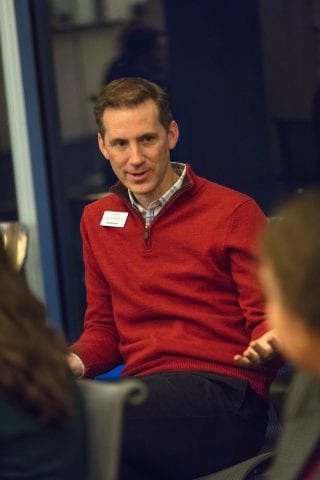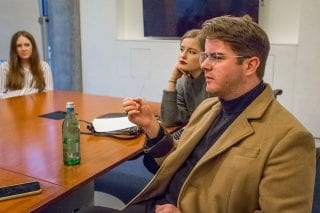
The “Museum 12” with Dean Coon and Honors College and Crystal Bridges staff in Crystal Bridges’ inner sanctum –– the vault! Photo: Daniel Moody.
Jackson Williams is a junior honors student at the University of Arkansas studying art history with minors in French and political science. Jackson is a native of Fayetteville, Arkansas, where he works as a freelance editor for Art Feeds and serves on the Distinguished Lectures Committee and the Honors College Advisory Council. After graduation, Jackson plans to pursue a doctorate in art history.

Crystal Bridges Executive Director Rod Bigelow solicits feedback from honors students enrolled in the Museum forum. Photo: Russell Cothren.
About halfway through the first discussion of the Honors College Forum: Museum, Executive Director and Chief Diversion and Inclusion Officer Rod Bigelow suggested we discuss the things about Crystal Bridges that we feel aren’t as successful as they could be. In that moment, I know I had a quiet panic, and I’m sure many of the other students in the class felt similarly. The executive director of Crystal Bridges asking a lowly undergraduate to point out flaws in the museum’s structuring seemed … like a trap. However, after a first response from one of my classmates it was clear that the executive strategy team was not trying to trick us into blacklisting ourselves from museum careers. Rather, Bigelow and his colleague, Dr. Margi Conrads, director of curatorial affairs and strategic art initiatives, were open to any criticism we could offer.
This moment, I believe, was an identifying one for Honors College Forum: Museum. At this point we all began to realize that we have found ourselves in a space where our input is as valuable as any other. Although our primary focus is to learn from leaders in the art museum world, those leaders might have a bit to learn from us too.
After this realization, we focused in a little closer on our topic of the week: mission statements. Bigelow and Conrads walked us through a brief survey of museum mission statements in the United States before putting a magnifying glass over Crystal Bridges’ own mission statement:
“The mission of Crystal Bridges Museum of American Art is to welcome all to celebrate the American spirit in a setting that unites the power of art with the beauty of nature.”
Once again, the executives asked us to use a critical eye. Feeling more comfortable, we dug our heels in and began picking apart the sentence word by word. As a class we determined that “celebrate the American spirit,” warranted the most deconstruction. The word “celebrate,” itself, many believed, has a positive, ritualistic, expectation embedded in its connotation; it is not unrelated to vanity. If we celebrate Christmas and we celebrate Valentine’s Day, maybe we should do something different when faced with the material culture of American history. For instance, take Albert Bierstadt’s Indian Encampment, which offers a voyeur’s view of a peaceful Native American settlement, but now serves as documentation of a culture destroyed by America. Is this a legacy we should celebrate? Or rather, should we reflect critically on these cruel times in our nation’s history? Finally, we deemed “celebrate” might be better replaced with “consider,” “engage with,” or “investigate,” in order to assert a focus on critical engagement with the art of the United States. “American spirit,” however vague, finds its value in the arbitrary. An “American spirit” cannot be defined simply, so perhaps this phrase is one that will foster guest contemplation.
The conversation in class was an exciting chance to see first-hand how willing the executives at Crystal Bridges are to engage with the public for the formulation of museum strategy. The culmination of our conversation was the output of an Honors College Museum-approved mission statement:
“Crystal Bridges welcomes all to encounter American stories in an environment dismantling barriers between nature and the arts.”

Jackson with classmates Rachel Hutchings (left) and Sloan Aulgur in the Crystal Bridges boardroom. Photo: Russell Cothren.
Ultimately, I can’t say that I was thrilled with this statement. I don’t believe the primary barrier between audience and art in any museum setting is a “barrier between nature and the arts,” as the arts so often encourage a consideration of nature and its beauty. Dismantling is a strong, effective word choice, but ultimately meaningless as the supposed barrier isn’t very valid. Rather, I believe the true Crystal Bridges mission is closer to the current one, albeit the tragic use of “celebrate,” which I would quickly swap for “engage with” in reference to the “American Spirit.” I believe the phrase “unite the power of art with the beauty of nature” is incredibly powerful in the original mission, although I agree with my colleague Max Frank that a nod to architecture in this statement would be effective.
I believe that in following the mission of the museum, active engagement with the public is necessary. If the museum wants to “welcome all” to celebrate or contemplate or criticize the American spirit, there is first the understanding that for many people viewing art is not a contemplative experience, and it might not be an enjoyable experience. There lies the importance of community outreach as well as programming—both educational and recreational. Crystal Bridges is a world-class art museum nestled into the northwest corner of Arkansas with the opportunity to grant easier access to American art to millions of people in Arkansas, Oklahoma, Missouri and Texas. As long as the museum continues to dedicate itself to eliminating any barriers to access, the mission is being followed.
